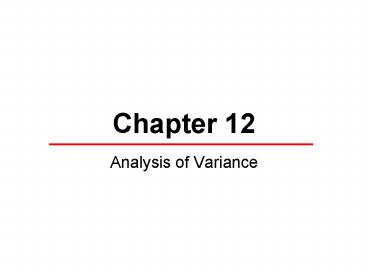Analysis of Variance PowerPoint PPT Presentation
1 / 17
Title: Analysis of Variance
1
Chapter 12
- Analysis of Variance
2
Section 12-1
- Many real-world problems involve a comparison
among several groups. - ? Which company will provide the best
automobile insurance?
3
- Comparing 2 means at a time would be too time
consuming with numerous groups to compare, so we
have a new method to use instead. - Analysis of Variance (ANOVA) is a method of
testing the equality of 3 or more population
means by analyzing sample variances. Its
purpose is to determine the existence (or not) of
a statistically significant difference among
group means.
4
- To do the test, we will use a new distribution
called the F Distribution - Non symmetric, skewed to the right (similar to
chi-square). - The values for F are or 0, but not negative.
- There is a different F distribution for each pair
of degrees of freedom for the numerator and
denominator. - The critical values are given in Table A-5.
5
Three F distribution curves.
df (1 , 3)
df (7 , 6)
df (12 , 40)
F
6
Section 12-2
One-Way ANOVA
- In this section, we will be testing the
hypothesis that three or more population means
are all equal.
7
Assumptions
- The populations have distributions that are
approximately normal. - The populations have the same variance ?2 (or
standard deviation ?). - The samples are simple random samples.
8
- 4. The samples are independent of each other.
- 5. The different samples are from populations
that are categorized in only one way (hence the
name one-way ANOVA). - A treatment/factor is a property, or
characteristic, that allows us to distinguish the
different populations from one another.
9
Definitions
- 1. Variance between samples
- ? estimates the common population variance that
is based on the variability among sample means. - Variance within samples
- ? estimates the common population
- variance based on sample variances.
10
- 3. Test statistic (with same size samples)
- If HO is true, the variance between the samples
and within the samples should be approximately
the same, so this value should be approximately 1.
11
- Degrees of Freedom with k samples of the same
size n - ?numerator degrees of freedom
- k 1
- ?denominator degrees of freedom
- k(n-1)
12
- For unequal sample sizes, we would use the
following test statistic - 4.
- Since the calculations required for analysis of
variance are lengthy, well use software and
learn to interpret the output provided.
13
- Procedure
- 1. Set up the hypotheses
- HO ?1 ?2 ?3
- H1 At least one of the means is
- different.
- 2. Use software to produce an ANOVA table.
14
- 3. Identify the P-value from the display.
- 4. Make a proper initial conclusion.
- 5. Write a statement in the context of the
problem.
15
Example 1
- Chest deceleration data (g) from car crash
experiments conducted by the National
Transportation Safety Administration are given
below. Use a 0.05 significance level to test the
null hypothesis that the different weight
categories have the same mean. Do the data
suggest that larger cars are safer?
16
- HO µ1 µ2 µ3 µ4
- H1 At least one of the means is different.
- Next,
- create the ANOVA table.
17

